Plastic Free July on the move: travelling plastic-free between challenges and good practices
Posted on

With most countries lifting the travel ban issued because of the Covid-19 pandemic, during this Plastic Free July (PFJ), our team travelled to diverse geographies (Africa, Europe and Asia) for academic commitments and leisure. Given our previous experience on PFJ, we knew that going plastic-free is challenging. In this blog, we share our reflections on travelling plastic-free, the issues and the good practices we encountered along the way.
There are a few tips for travelling plastic-free that we usually adopt. For example, take a reusable water bottle and find a fountain, use a reusable mug for coffee or tea, carry water sterilising tablets for local water, cleaning products and possibly some camping cutlery or avoid takeaway and fast-food restaurants that commonly use disposable plastic cutlery. Also, the destination matters; if you know your way around, you may have a better chance of avoiding single-use plastics, e.g., by shopping at plastic-free shops and eating in plastic-free restaurants. However, most of us encounter diverse challenges when travelling last July.
Challenges on the move
To start, some of us had never been to certain destinations or travelled through different places on route. We had no idea where we were going. We also had to consider that we were flying or taking the train (therefore, having to carry our luggage at any change and once at destination) and had limited space. In fact, before leaving, the first challenge for several of us was finding enough space in our baggage. We needed to pack for up to over a week in certain cases, and because several of us were travelling for work (e.g., conferences, meetings, partner visits), our itinerary included formal and informal activities; our luggage was filled with different outfits, shoes, even a graduation gown and work items that needed to be shipped with us.
Furthermore, none of us who travelled via air trusted leaving any technological device in the checked-in luggage; we had to travel with a small cabin bag containing a laptop, tablet, phones, and chargers, as well as other items we preferred to keep close at hand. This left little room for a reusable water bottle or mug. This represented a relative issue for those of us travelling by train as they managed to keep with them at least their reusable water bottle and, when the luggage was not too heavy, their reusable coffee cup (although they had to make sure it did not spill any liquid on their clothes in some cases!). On the other hand, another problem that people who flew had was the impossibility of travelling with a cutlery set because knives, even if not sharpened or pointy, are not permitted on board planes. That brings us to the next point, safety.
Even if planned in advance, and those travelling on planes could have found room for a bottle or mug, travelling with these with liquids would have violated airline safety regulations in some instances. Therefore, we had to rely on the availability of drinkable water from washrooms or fountains in the airports that were travelled through. There was the possibility that the plane crews did not accept reusable mugs and bottles for refilling or in airport cafés due to covid restrictions that were still in place in some countries. Due to these issues, plane travellers found it easier to rely on single-use plastics for drinking and eating during their journeys, often quite long (e.g., the 20 hours of flight to Kuala Lumpur, Malaysia). Or go without food and drink until they arrived.
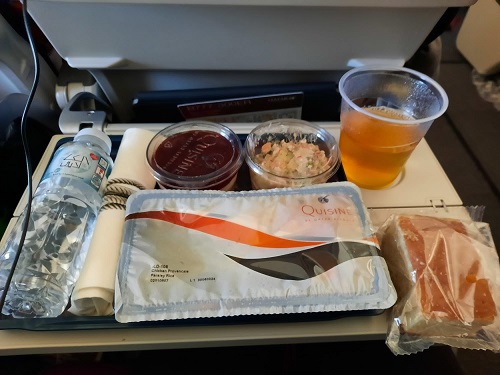
Ph Credits: Alison Stowell. A meal on the flight comes in a variety of plastic packaging.
Although people travelling by train could bring with them filled reusable bottles and cups, due to space constraints and hygiene considerations (they did not want to touch their food too much while not having the possibility of washing their hands), they sometimes relied on packaged snacks for their journey.
Another issue for all of us who experienced their PFJ on the move was the packaging option in case we forgot something from home, e.g., toiletries often come in single-use plastic or packaged with heavy plastic packaging (e.g., toothbrushes or razors) or clothing and underwear (plastic film is often used to wrap these goods and protect them from dust and dirt). One of us commented on their frustration when, realising they forgot their toothbrush, they looked at the range of options available in the nearest store. Not finding anything but a plastic toothbrush, they resolved to make their first single-use plastic packaging purchase of that trip. “[I] Feel like I’d let myself down there.”, they commented. Another in our team had their luggage delayed and had to buy clothes necessary for a few days, not having much choice but to purchase various amounts of plastic packaging.
Access to public drinkable water was another issue that most of us encountered even after arriving at our destination. “Travel is something I enjoy,” one of us stated, “however, our gut microbiota is controlled to a certain extent by the source of water we drink, and I have found that changing tap water can be complicated […], so now I only drink bottled water in African countries”.
In several geographies where tap water is not considered “safe” for visitors, plastic bottles represent “a carrier of precious, clean water” when water purifying tablets are not an option. When in Kuala Lumpur, some of us noticed how people rely primarily on various sizes of bottled water– but visitors, like us, mostly had access to half-litre bottles in small shops and cafés. Although the hotel was new and located in the revalued city of Sunway (once an abandoned tin mine, transformed into an example of a sustainable and liveable city with Sunway University at its core), the two of us travelling there were unable to drink tap water. When we asked the receptionist, they immediately replied “no!” with a worried expression, as if our teammates had drunk from the tap already (they had not). The hotel provided guests with as many half-litre water bottles as they needed for free.
Our teammates estimated that drinking 65 bottles during their stay. Given the bottle characteristics, such as the fact that the bottles were made of PET, and the label, which was made of plastic rather than paper, and was not glued, a strategy useful for recycling PET, we hoped that they were able to refill or recycle the bottles.
Recycled or not, as one of us who stayed in the Mediterranean area reflected, does the consumption of plastic bottles for drinking clean water “to some extent absolve me (and others) from buying plastic bottles in this instance? It certainly didn’t feel like it should. Although, I did relieve myself of some of my guilt by reminding myself that I was on a short visit, and this was a temporary arrangement. I also felt that I didn’t really have any other option.”. However, we could see the aftermath of our behaviour in the beautiful places we visited, as the photos of a charming cove filled with plastic debris in the Mediterranean sea below show.
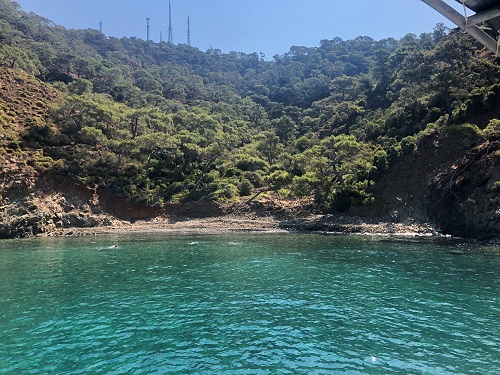
Ph Credits: Charlotte Hadley. A beautiful cove and plastic debris
While visiting another tourist spot, the Batu Caves in Kuala Lumpur, some of us noticed a concerning amount of litter. Although being a popular Hindu religious destination right outside the capital city, we noticed a lot of single-use plastic litter, such as water bottles, hand gel containers, bags and takeaway food packaging. The monkeys appeared to be accustomed to sucking liquids (including hand sanitiser) from abandoned (or in many cases stolen) bottles and containers, which made us concerned for the health of those animals.
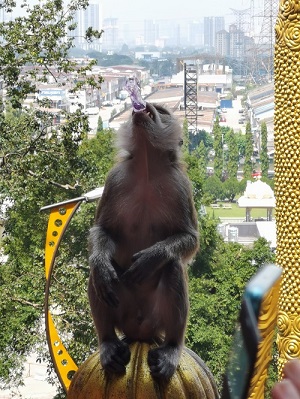
Ph Credits: Marta Ferri. Monkeys drinking hand sanitiser and sucking liquids out of plastic packaging.
Good practices found along the way
Although the consistent and worrying presence of single-use plastic litter and, sometimes, the impracticability of avoiding it, during our PFJ ‘on the move’ experience, we found that single-use plastics are not always the best option for everyday use.
For example, even though most places visited did not have access to public drinkable water, the Sunway University campus (Malaysia) had public water fountains on almost every floor.
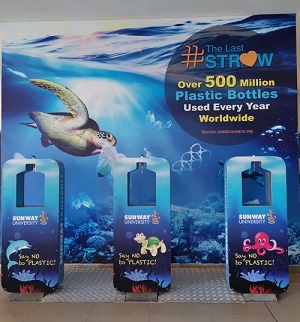
Ph Credits: Marta Ferri. Fountain station in Sunway University campus.
As the photo above shows, the availability of fountains was part of Sunway University’s commitment to addressing the plastic crisis and, in particular, the United Nations (UN) Sustainable Development Goal (SDG) 14, “Life Below Water”. SDG 14 is frequently cited as a framework for addressing marine plastic pollution. The University encouraged students and staff to bring their own reusable bottles and mugs (which were accepted in several cafés around campus), an initiative that promotes the reduction of single-use plastic bottles and cups.
One more good practice observed while travelling in a coastal area of the Mediterranean area was “shaped like a bottle” bins along the shorelines and docks for passers to dispose of their bottles.

Ph Credits: Charlotte Hadley. “Bottle-shaped” bins.
“Looking at the simplicity of the design”, one of us reflected, “the size (fairly difficult to miss) and the shape (evidently recognisable as a bottle) of these bins, it becomes instantaneously clear what these containers are for. I found them to be quite effective, particularly given that I couldn’t read or speak the native language.” This made us think about the value of creating simple, visual communication aids that surpass language barriers and are easy to understand, particularly where recycling is concerned.”
Moving on to considering food and eating habits, some of us encountered an interesting practice when attending diverse academic events in the UK. The catering offered compostable cutlery and plates made of palm leaf, bamboo, and wood.
Although realising that those materials served as a great plastic alternative, we found it important to reflect on the resources used to produce those and, on balance, how they compare with plastics, e.g., in terms of water consumption and emissions for growing the plants, manufacturing the objects and how they are managed once becoming waste. Another example, born within Sunway University (Malaysia), that aspires to spread throughout the city is Dr Jane Gew and Chef Soon’s Food Waste Reduction and Composting initiative. Chef Soon runs his teaching kitchen according to a zero-waste philosophy that sees the reduction of single-use plastics, e.g., using reusable plastic mini-trays for portioning dessert and food waste that is collected separately and used to create dry compost.
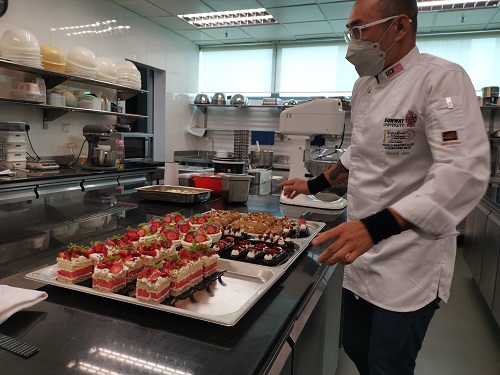
Ph Credits: Alison Stowell. Chef Soon prepares single-serving desserts on reusable plastic trays.
In terms of street food habits, while plastics represent a safe choice (in terms of health and safety) when eating in street markets in certain geographies, in Malaysia, for example, some dishes, such as the popular (and delicious) nasi lemak in the photo below, are sold wrapped in banana leaves and paper sheets, rather than plastic packaging.

Ph Credits: Marta Ferri. Nasi lemak wrapped in banana leaves and a sheet of paper. Dinner on her way to the Kuala Lumpur airport.
Overall, our PFJ travelling experience was significant in highlighting the main challenges in ditching plastic while travelling and where we could improve.
The main challenges are having enough space for reusable bottles and mugs, having access to public drinkable water along the journey and at the destination, and COVID-19 restrictions (that prevent refilling reusable bottles and mugs in public spaces and shops). Opportunities for improving our travelling habits include finding alternatives to plastic packaging for food and beverages within local realities, e.g., the previously mentioned street food version of a nasi lemak, and discovering sustainable practices around us, e.g., the wired bottle-shaped bins in the coastal area in the Mediterranean.
Authors: Marta Ferri, Dr Alison Stowell, Dr Charlotte Hadley, Dr Clare Mumford, Prof. Maria Piacentini, Dr Alex Skandalis, Dr John Hardy, Prof. Linda Hendry, Dr Savita Verma, Dr James Cronin.
Related Blogs
Disclaimer
The opinions expressed by our bloggers and those providing comments are personal, and may not necessarily reflect the opinions of Lancaster University. Responsibility for the accuracy of any of the information contained within blog posts belongs to the blogger.
Back to blog listing




